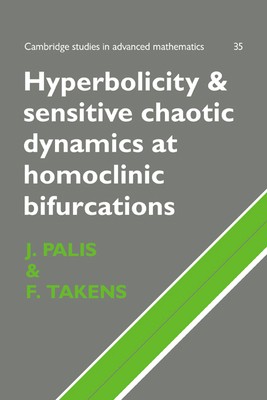
- We will send in 10–14 business days.
- Author: Jacob Palis
- Publisher: Cambridge University Press
- ISBN-10: 0521475724
- ISBN-13: 9780521475723
- Format: 15.2 x 22.6 x 2 cm, minkšti viršeliai
- Language: English
- SAVE -10% with code: EXTRA
Hyperbolicity and Sensitive Chaotic Dynamics at Homoclinic Bifurcations (e-book) (used book) | bookbook.eu
Reviews
Description
This is a self-contained introduction to the classical theory of homoclinic bifurcation theory, as well as its generalizations and more recent extensions to higher dimensions. It is also intended to stimulate new developments, relating the theory of fractal dimensions to bifurcations, and concerning homoclinic bifurcations as generators of chaotic dynamics. The book begins with a review chapter giving background material on hyperbolic dynamical systems. The next three chapters give a detailed treatment of a number of examples, Smale's description of the dynamical consequences of transverse homoclinic orbits, and a discussion of the subordinate bifurcations that accompany homoclinic bifurcations, including Hénon-like families. The core of the work is the investigation of the interplay between homoclinic tangencies and non-trivial basic sets. The fractal dimensions of these basic sets turn out to play an important role in determining which class of dynamics is prevalent near a bifurcation. The authors provide a new, more geometric proof of Newhouse's theorem on the co-existence of infinitely many periodic attractors, one of the deepest theorems in chaotic dynamics.
EXTRA 10 % discount with code: EXTRA
The promotion ends in 23d.04:12:14
The discount code is valid when purchasing from 10 €. Discounts do not stack.
- Author: Jacob Palis
- Publisher: Cambridge University Press
- ISBN-10: 0521475724
- ISBN-13: 9780521475723
- Format: 15.2 x 22.6 x 2 cm, minkšti viršeliai
- Language: English English
This is a self-contained introduction to the classical theory of homoclinic bifurcation theory, as well as its generalizations and more recent extensions to higher dimensions. It is also intended to stimulate new developments, relating the theory of fractal dimensions to bifurcations, and concerning homoclinic bifurcations as generators of chaotic dynamics. The book begins with a review chapter giving background material on hyperbolic dynamical systems. The next three chapters give a detailed treatment of a number of examples, Smale's description of the dynamical consequences of transverse homoclinic orbits, and a discussion of the subordinate bifurcations that accompany homoclinic bifurcations, including Hénon-like families. The core of the work is the investigation of the interplay between homoclinic tangencies and non-trivial basic sets. The fractal dimensions of these basic sets turn out to play an important role in determining which class of dynamics is prevalent near a bifurcation. The authors provide a new, more geometric proof of Newhouse's theorem on the co-existence of infinitely many periodic attractors, one of the deepest theorems in chaotic dynamics.


Reviews